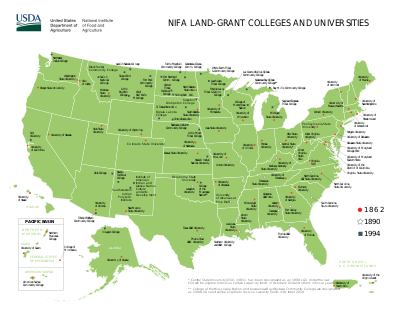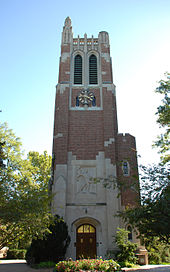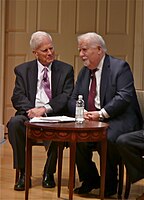Morrill Land-Grant Acts
| , enacted August 30, 1890 |
The Morrill Land-Grant Acts are
Passage of original bill
For 20 years prior to the first introduction of the bill in 1857, there was a political movement calling for the creation of agriculture colleges. The movement was led by Professor
On February 8, 1853, the
Unlike the Turner Plan, which provided an equal grant to each state, the Morrill bill allocated land based on the number of senators and representatives each state had in Congress. This was more advantageous to the more populous eastern states.[6]
The Morrill Act was first proposed in 1857, and was passed by Congress in 1859, but it was vetoed by President James Buchanan. In 1861, Morrill resubmitted the act with the amendment that the proposed institutions would teach military tactics as well as engineering and agriculture.[7] Aided by the secession of many states that did not support the plans, the reconfigured Morrill Act was signed into law by President Abraham Lincoln on July 2, 1862.
Land-grant colleges


The purpose of the land-grant colleges was:
without excluding other scientific and classical studies and including military tactic, to teach such branches of learning as are related to agriculture and the mechanic arts, in such manner as the legislatures of the States may respectively prescribe, in order to promote the liberal and practical education of the industrial classes in the several pursuits and professions in life.[8]
From the early to mid-19th century the federal government, through 162 violence-backed cessions, expropriated approximately 10.7 million acres of land from 245 tribal nations and divided it into roughly 80,000 parcels for redistribution.[9] Under the act, each eligible state received 30,000 acres (120 km2) of federal land, either within or contiguous to its boundaries, for each member of congress the state had as of the census of 1860. This land, or the proceeds from its sale, was to be used toward establishing and funding the educational institutions described above. Under provision six of the Act, "No State while in a condition of rebellion or insurrection against the government of the United States shall be entitled to the benefit of this act," in reference to the recent secession of several Southern states and the contemporaneously raging American Civil War. However, after the war, in the 1870s, Mississippi, Virginia, and South Carolina each assigned one African American college land grant status; these were, respectively, Alcorn University, Hampton Institute, and Claflin University.[10]
In 1890 the 1862 Act was extended to the former Confederate states (see below for more detailed information), and it was eventually extended to every state and territory, including those created after 1862. If the federal land within a state was insufficient to meet that state's land grant, the state was issued scrip which authorized the state to select federal lands in other states to fund its institution.[11] For example, New York carefully selected valuable timber land in Wisconsin to fund Cornell University.[12]: 9 The resulting management of this scrip by the university yielded one third of the total grant revenues generated by all the states, even though New York received only one-tenth of the 1862 land grant.[12]: 10 Overall, the 1862 Morrill Act allocated 17,400,000 acres (70,000 km2) of land, which when sold yielded a collective endowment of $7.55 million.[12]: 8
On September 12, 1862, the
The land grant colleges transformed
With a few exceptions (including Cornell University and the Massachusetts Institute of Technology), nearly all of the land-grant colleges are public. (Cornell University, while private, administers several state-supported statutory colleges that fulfill its public land-grant mission to the state of New York.)
To maintain their status as land-grant colleges, a number of programs are required to be maintained by the college. These include programs in agriculture and engineering, as well as a Reserve Officers' Training Corps program.
Expansion
The second Morrill Act (1890) was also aimed at the former
Later on, other colleges such as the University of the District of Columbia and the "1994 land-grant colleges" for Native Americans were also awarded cash by Congress in lieu of land to achieve "land-grant" status.
In imitation of the
Agricultural experiment stations and cooperative extension service
Starting in 1887, Congress also funded
-
Celebration of the 150th Anniversary of the Morrill Act, at the Library of Congress, June 23, 2012
-
James H. Billington and Vartan Gregorian at the Celebration of the 150th Anniversary of the Morrill Act, 2012
See also
- Agricultural Experiment Stations Act of 1887
- Association of Public and Land-grant Universities
- Hatch Act of 1887
- Land-grant university
- List of land-grant universities
- Manual labor college
- Smith-Lever Act of 1914
- United States Department of Agriculture
References
- ^ https://govtrackus.s3.amazonaws.com/legislink/pdf/stat/12/STATUTE-12-Pg503a.pdf [bare URL PDF]
- JSTOR 2763175.
- ^ "Michigan Constitution of 1850". Wikisource. Article 13, Section 11. Retrieved March 5, 2008.
- ^ "Milestones of MSU's Sesquicentennial Archived 2007-08-06 at the Wayback Machine". MSU University Archives and Historical Collection. Retrieved March 5, 2008.
- ^ Letter from Lyman Trumbull to J.B. Turner, 1857-10-19.
- ^ Carl L. Becker, Cornell University Founders and The Founding (Cornell University Press 1943), pp. 28–30.
- ^ "Justin Smith Morrill (1810-1898)" in The Latin Library http://www.thelatinlibrary.com/chron/civilwarnotes/morrill.html.
- ^ 7 U.S.C. § 304
- ^ Lee, Robert; Ahtone, Tristan; Pearce, Margaret; Goodluck, Kalen; McGhee, Geoff; Leff, Cody; Lanpher, Katherine; Salinas, Taryn (March 30, 2020). "Land-Grab Universities". High Country News. Retrieved April 21, 2020.
- ^ John W. Davis, "The Negro Land-Grant College," 2 Journal of Negro Education p.312 (1933)
- ^ 7 U.S.C. § 302
- ^ a b c Whalen, Michael L. (May 2001). "A Land-Grant University" (PDF). Cornell University. Archived (PDF) from the original on February 28, 2008. Retrieved August 25, 2020.
- ^ "History of Iowa State: Time Line, 1858–1874". Iowa State University. 2006. Archived from the original on May 13, 2009. Retrieved July 9, 2009.
- ^ "The National Schools of Science", The Nation: 409, November 21, 1867
- ^ Frederick Rudolph, Curriculum: A History of the American Undergraduate Course of Study Since 1636 p.36 (1978)
- ^ Williams, Daniel E. (Spring 2009), "Morrill Act's Contribution to Engineering's Foundation" (PDF), Tau Beta Pi the Bent
- ^ 7 U.S.C. § 323
- ^ Debra Reid, "People's Colleges for Other Citizens: Black Land-Grant Institutions and the Politics of Educational Expansion in the Post-Civil War Era," in Science as Service: Establishing and Reformulating American Land-Grant Universities, 1865-1930 p. 144 (2015).
- ^ 7 U.S.C. § 361a
- ^ USDA Budget Summary 2006 - Research, Education, and Economics Archived December 1, 2007, at the Wayback Machine
- ^ "CSREES FY2008 President's Budget Proposal" (PDF). Archived from the original (PDF) on February 17, 2012. Retrieved February 12, 2013.
Further reading
- Cross, Coy F. Justin Smith Morrill, Father of the Land-Grant Colleges. Michigan State University Press: 1999. ISBN 978-0-87013-508-8. online
- Singh, Vineeta. "Inclusion or acquisition? Learning about justice, education, and property from the Morrill Land-Grant Acts." Review of Education, Pedagogy, and Cultural Studies 43.5 (2021): 419–439.
- Sorber, Nathan M. Land-grant colleges and popular revolt: The origins of the Morrill Act and the reform of higher education (Cornell University Press, 2018) online.
- Lee, Robert and Tristan Ahtone. 2020. "How They Did It: Exposing How U.S. Universities Profited From Indigenous Land" PulitzerCenter.org
- Wallenstein, Peter. 2018. "The Morrill Land Grant College Act of 1862 : seedbed of the American system of public universities." Civil War Congress and the creation of modern America : a revolution on the home front. Ohio University Press. ISBN 9780821423387
- Zdzienicka Fanshe, Rosalie. 2020. "The Morrill Act as Racial Contract: Settler-Colonialism and U.S. Higher Education" EScholarship.org
External links
- "Text and PDF of original 1862 manuscript of Morrill Act". OurDocuments.gov. U.S. National Archives and Records Administration. February 11, 2024.
- An Audacious Act: How a High School Dropout Helped Educate America. Amherst, MA: New England Public Radio. September 21, 2013. Archived from the original on November 1, 2013. Retrieved December 10, 2013. A radio documentary on the Morrill Land-Grant Acts.


